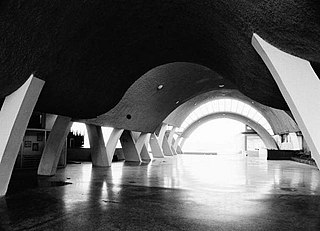
In physics and geometry, a catenary is the curve that an idealized hanging chain or cable assumes under its own weight when supported only at its ends.

The Gateway Arch is a 630-foot (192 m) monument in St. Louis, Missouri, United States. Clad in stainless steel and built in the form of a weighted catenary arch, it is the world's tallest arch, the tallest man-made monument in the Western Hemisphere, and Missouri's tallest accessible building. Built as a monument to the westward expansion of the United States, and officially dedicated to "the American people," the Arch, commonly referred to as "The Gateway to the West" is the centerpiece of Gateway Arch National Park and has become an internationally recognized symbol of St. Louis, as well as a popular tourist destination.
In commutative algebra, the Krull dimension of a commutative ring R, named after Wolfgang Krull, is the supremum of the lengths of all chains of prime ideals. The Krull dimension need not be finite even for a Noetherian ring. More generally the Krull dimension can be defined for modules over possibly non-commutative rings as the deviation of the poset of submodules.
An overhead line or overhead wire is used to transmit electrical energy to trains, trolleybuses or trams. It is known variously as:

A catenoid is a type of surface, arising by rotating a catenary curve about an axis. It is a minimal surface, meaning that it occupies the least area when bounded by a closed space. It was formally described in 1744 by the mathematician Leonhard Euler.

An ogive is the roundly tapered end of a two-dimensional or three-dimensional object. Ogive curves and surfaces are used in engineering, architecture and woodworking.
In mathematics, a Cohen–Macaulay ring is a commutative ring with some of the algebro-geometric properties of a smooth variety, such as local equidimensionality. Under mild assumptions, a local ring is Cohen–Macaulay exactly when it is a finitely generated free module over a regular local subring. Cohen–Macaulay rings play a central role in commutative algebra: they form a very broad class, and yet they are well understood in many ways.

A tractrix is the curve along which an object moves, under the influence of friction, when pulled on a horizontal plane by a line segment attached to a tractor (pulling) point that moves at a right angle to the initial line between the object and the puller at an infinitesimal speed. It is therefore a curve of pursuit. It was first introduced by Claude Perrault in 1670, and later studied by Isaac Newton (1676) and Christiaan Huygens (1692).

A simple suspension bridge is a primitive type of bridge in which the deck of the bridge lies on two parallel load-bearing cables that are anchored at either end. They have no towers or piers. The cables follow a shallow downward catenary arc which moves in response to dynamic loads on the bridge deck.
Masayoshi Nagata was a Japanese mathematician, known for his work in the field of commutative algebra.
In commutative algebra, a quasi-excellent ring is a Noetherian commutative ring that behaves well with respect to the operation of completion, and is called an excellent ring if it is also universally catenary. Excellent rings are one answer to the problem of finding a natural class of "well-behaved" rings containing most of the rings that occur in number theory and algebraic geometry. At one time it seemed that the class of Noetherian rings might be an answer to this problem, but Nagata and others found several strange counterexamples showing that in general Noetherian rings need not be well behaved: for example, a normal Noetherian local ring need not be analytically normal. The class of excellent rings was defined by Alexander Grothendieck (1965) as a candidate for such a class of well-behaved rings. Quasi-excellent rings are conjectured to be the base rings for which the problem of resolution of singularities can be solved; Heisuke Hironaka (1964) showed this in characteristic 0, but the positive characteristic case is still a major open problem. Essentially all Noetherian rings that occur naturally in algebraic geometry or number theory are excellent; in fact it is quite hard to construct examples of Noetherian rings that are not excellent.
In mathematics, a commutative ring R is catenary if for any pair of prime ideals

Club Náutico(Nautical Club) was originally built in the 1920s and expanded in 1936 by its owner Carlos Fernández. Guests paid a modest fee, eventually there were more than five thousand subscribers. Fernández had in addition to the enjoyment of a short beach, a dance floor with an orchestra. By the 1950s, an increase in membership necessitated expansion of the original premises in 1953 and Max Borges Recio designed a set of porticos covered by vaults similar to the ones he recently had designed for the Tropicana. It is located at Terminus of 152, Nautico, Playa, Havana, Cuba.

Stockport Viaduct carries the West Coast Main Line across the valley of the River Mersey in Stockport, Greater Manchester, England. It is one of the largest brick structures in the United Kingdom.

A parabolic arch is an arch in the shape of a parabola. Such arches are used in bridges, cathedrals, and elsewhere in architecture and engineering.

A catenary arch is a type of architectural arch that follows an inverted catenary curve. The catenary curve has been employed in buildings since ancient times. It forms an underlying principle to the overall system of vaults and buttresses in stone vaulted Gothic cathedrals and in Renaissance domes. It is not a parabolic arch.

The New York, New Haven and Hartford Railroad pioneered electrification of main line railroads using high-voltage, alternating current, single-phase overhead catenary. It electrified its mainline between Stamford, Connecticut, and Woodlawn, New York, in 1907, and extended the electrification to New Haven, Connecticut, in 1914. While single-phase AC railroad electrification has become commonplace, the New Haven's system was unprecedented at the time of construction. The significance of this electrification was recognized in 1982 by its designation as a National Historic Engineering Landmark by the American Society of Mechanical Engineers (ASME).

In mathematics, a minimal surface of revolution or minimum surface of revolution is a surface of revolution defined from two points in a half-plane, whose boundary is the axis of revolution of the surface. It is generated by a curve that lies in the half-plane and connects the two points; among all the surfaces that can be generated in this way, it is the one that minimizes the surface area. A basic problem in the calculus of variations is finding the curve between two points that produces this minimal surface of revolution.

A weighted catenary is a catenary curve, but of a special form. A "regular" catenary has the equation











